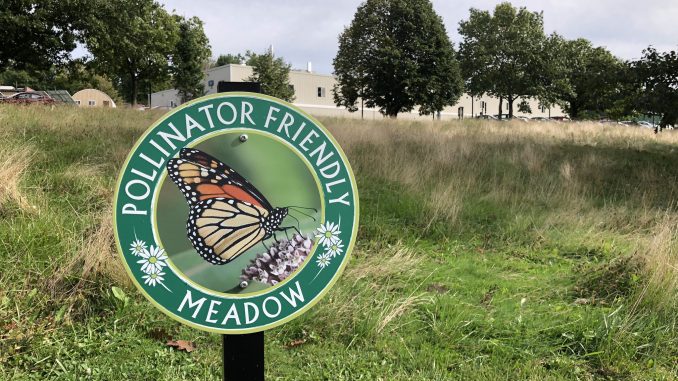
The State University of New York (SUNY) at New Paltz continues with its desire to become more environmentally conscious, with the latest buzz surrounding the college’s certification as an official Bee Campus USA this summer.
In Sept. 2018, Chair of the Bee Committee and New Paltz alumna Laura Wyeth (‘18) took a new Biodiversity Initiative from the Office of Campus Sustainability under her wing, and the first item on her agenda was to secure this pollinator-friendly status. This initiative has connected faculty who are “concerned about the natural world,” according to Campus Sustainability Coordinator Lisa Mitten, in addition to students and staff who desire to support and protect living organisms found on campus and in the community.
According to data collected by Bee City USA, an initiative of the Xerces Society, there are currently 80 official Bee Campuses in the nation, with five of these based in New York State. Apart from SUNY Cortland, New Paltz is the only SUNY campus to have achieved this affiliation as of now.
In order to become a Bee Campus, a campus pollinator habitat plan must first be created, which New Paltz has completed, according to Wyeth. As a horticulturist and instructor of biology herself, Wyeth gathered information from her own experiences and other credible sources to compile this research document. The plan includes bees’ typical life cycles and why they require human support to help them survive.
After forming this plan, a habitat must be created for flowering plants, grasses and pollinators, such as bees, butterflies, moths and beetles.
According to Bee City USA, insect pollination is responsible for one in three bites of food consumed, and roughly 90% of flowering plants rely on pollinators for reproduction value. According to Wyeth, the greatest threats to pollinators in today’s world include habitat loss, environmental pollution and the climate crisis.
“In supporting habitat, the biggest thing that we wanted to do was find an area that we could leave alone,” Wyeth said. “We could create these elaborate gardens that require a lot of work, but they still wouldn’t be as diverse. We particularly allowed a lawn to ‘go wild.’ If you leave a place alone, the plants will find their way in.”
In line with the determination to spark conversation about this matter, Bee Campus USA affiliates continuously raise awareness and educate the campus community in order to keep their status as a Bee Campus. On Tuesday, Sept. 3, an interactive tour was held by Wyeth in honor of SUNY New Paltz’s environmental achievement. This allowed attendees to discover different pollinators, plants and biodiversity locations on campus. Educational signage has also been situated by the meadow at the southern end of campus, where people are able to stroll on a path alongside the largest section of the Saw Mill Brook, which is widely referred to by locals as the “Gunk stream.”
Additionally, in an effort to maintain and support flowering plants and pollinators, facilities management stopped mowing at four different locations across campus this past spring, and will only do so about every year and a half from this point forward, according to Wyeth. These areas will be trimmed to avoid the growth of woody shrubs and trees that overtime lead to forest.
“I take care of the Greenhouse, and I meet people all the time who just want to connect to something living,” Wyeth said. “Also, as we know, everyone is now living in this age of anxiety, and this is one of the antidotes: to just stand here and listen to the katydids and frogs and birds and whatever else, and kind of let the worries melt away for a minute.”
Other existing pollinator habitats on campus include the Vegetated Bioswale between Ashokan Hall and the “Gunk stream,” the Green Roof Garden in front of Haggerty Administration Building and the small perennial garden between the Student Union Building and the Dorsky Arts Museum.
While there are currently no other concrete plans to specifically engage students in the goals of the Biodiversity Initiative, Wyeth explained that those already involved hope that these areas of nature will serve as a teaching tool to the campus community.
Additionally, service learning projects and other ways to include students of all experiences and disciplines are actively being considered to implement and increase awareness towards sustainability and environmental efforts. Wyeth encourages students and community members to take a moment to review and reflect on the nature present in their own backyards.
“This is all environment right here. Not just the Mohonk Preserve, not just the Hudson River and everything. It’s every little piece of territory,” Wyeth said. “It’s these lawns that we maintain, it’s these shrubs that were planted here and it’s the creatures that live in them. Even if we don’t think that [the species] are doing something for us, they have just as much right to be here and to live their lives as we do.”
For more information or to see how you can get involved with the development of the Biodiversity Initiative on campus, you can email Wyeth at wyethl1@newpaltz.edu.

